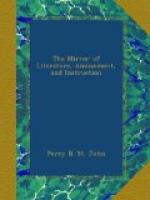* * * * *
FLUTE PLAYING.
“Will you play upon this pipe?”
“My Lord, I cannot.” So say we; but some novel instruction on the subject may not be unacceptable to our piping friends. We recommend to them “The Elements of Flute-playing, according to the most approved principles of Fingering,” by Thomas Lindsay, as containing more practical and preceptive information than is usually to be met with in such works. The advantage in the present treatise arises out of one of the many recent improvements in the art of printing, viz., the adoption of movable types for printing music, instead of by engraved pewter plates; which method enables the instructor to amplify his precepts, or didactic portion of his work, and thus simplify them to the pupil. According, in Mr. Lindsay’s treatise, we have upwards of forty pages of elementary instructions, definitions, and concise treatises, copiously interspersed with musical illustrations; whereas the engraved treatises are generally meagre in their instructions, from the difficulty of punching text illustrations. The article on accentuation is, we are told, the first successful attempt in any elementary work on the Flute, to define this important subject. It is written in a lucid and popular style, and is so attractive, that did our room allow, we might be induced to insert part of it. Appended to the treatise are thirty pages of Duettinos and Exercises, and altogether the work, (of which the present is Part I.,) is well worth the attention of such as study Flute-playing, which, as Mr. L. observes, is “one of those elegant and delightful recreations, which constitutes, at once, the grace and the solace of domestic life.”
* * * * *
The sweetest flowers their odours shed
In silence and alone;
And Wisdom’s hidden fount is fed
By minds to fame unknown.
Bernard Barton.
* * * * *
CHANGES OF INSECTS.
Insects are strikingly distinguished from other animals, by a succession of changes in their organization and forms, and by their incapacity of propagating before their last metamorphosis, which, in most of them, takes place shortly before their death. Each of these transformations is designated by so many terms, that it may not be useless to observe to the reader, who has not previously paid attention to the subject, that larva, caterpillar, grub, maggot, or worm, is the first state of the insect on issuing from the egg; that pupa, aurelia, chrysalis, or nympha are the names by which the second metamorphosis is designated, and that the last stage, when the insect assumes the appearance of a butterfly, is called the perfect state.—North American Review.




